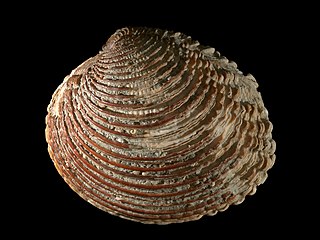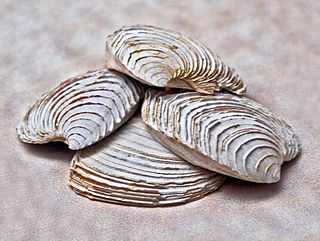
The hard clam, also known as the round clam, hard-shellclam, or the quahog, is an edible marine bivalve mollusk that is native to the eastern shores of North America and Central America from Prince Edward Island to the Yucatán Peninsula. It is one of many unrelated edible bivalves that in the United States are frequently referred to simply as clams. Older literature sources may use the systematic name Venus mercenaria; this species is in the family Veneridae, the venus clams.

The Veneridae or venerids, common name: Venus clams, are a very large family of minute to large, saltwater clams, marine bivalve molluscs. Over 500 living species of venerid bivalves are known, most of which are edible, and many of which are exploited as food sources.

Mercenaria is a genus of edible saltwater clams, marine bivalve molluscs in the family Veneridae, the Venus clams.

Venus is a genus of small to large saltwater clams in the family Veneridae, which is sometimes known as the Venus clams and their relatives. These are marine bivalve molluscs.

Corbicula is a genus of freshwater and brackish water clams, aquatic bivalve mollusks in the family Cyrenidae, the basket clams. The genus name is the Neo-Latin diminutive of Latin corbis, a basket, referring to the shape and ribs of the shell.

Leukoma is a genus of saltwater clams, marine bivalve molluscs in the family Veneridae, the Venus clams. This genus of bivalves has been exploited by humans since prehistory; for example, the Chumash peoples of California harvested this genus from Morro Bay in approximately 1000 AD.
Saxidomus, common name the "Washington clams", is a genus of large edible saltwater clams, marine bivalve mollusks in the family Veneridae, the Venus clams.

Chamelea is a genus of small saltwater clams, marine bivalve molluscs in the family Veneridae, the venus clams.

Petricolaria is a genus of saltwater clams, marine bivalve mollusks in the family Veneridae, the Venus clams.

Petricolaria pholadiformis, common names false angelwing, or false angel wing (US), and American piddock (UK), is a species of saltwater clam, a marine bivalve mollusk in the family Veneridae, the Venus clams.

Ruditapes largillierti is a saltwater clam, a marine bivalve mollusc in the family Veneridae, the Venus clams. They are moderately large for their genus, elongate and subrectangular, thick and solid, with smooth ventral margin.
Agriopoma is a genus of saltwater clams, marine bivalve molluscs in the family Veneridae, the venus clams.

Macrocallista maculata, or the calico clam, is a species of bivalve mollusc in the family Veneridae. It can be found along the Atlantic coast of North America, ranging from North Carolina to Bermuda and Brazil.

Macrocallista nimbosa, or the sunray venus clam, is a species of bivalve mollusc in the family Veneridae.

Pelecyora is a genus of saltwater clams, marine bivalve molluscs in the family Veneridae, the venus clams.

Circomphalus is a genus of saltwater clams, marine bivalve molluscs in the family Veneridae, the venus clams.

Callista is a genus of saltwater clams, marine, bivalve molluscs in the family Veneridae, the venus clams.

Paratapes is a genus of saltwater clam, a marine bivalve mollusk in the family Veneridae, the Venus clams.

Chionopsis, is a genus of saltwater clam, a marine bivalve mollusc in the family Veneridae, the venus clams.















